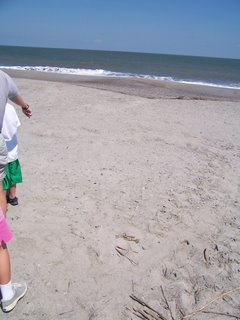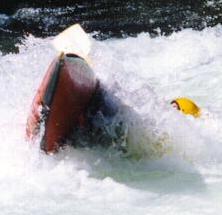One of the things they told us in the lecture was that a large portion of the beach had been “renourished” over the winter. This is when offshore sand is dredged up and pumped on shore to replace beach that has been lost due to the action of waves and tides. [That barrier islands are in the long run rather mobile and do not respect the temporary structures of man and his concepts of property and real estate is a long discussion for another day.] This sand has a different texture than the original sand – it is hard for me now to say exactly how. My impression of it was that it was a finer texture but had lots of bits of broken shell and other debris. The rangers said that the turtles have noticed the difference, too and seem to prefer the “good ole Edisto sand” – the renourishment project ranged from the “town beach” into the state park, but did not reach all the way to the end – about a mile of the beach beyond the campground has “virgin” sand.
Stars
As our walk proceeded down the beach, passing the campground to where the island tapered to a narrow slice between marsh and ocean, we came to this virgin sand. At this point the rangers said that we would stay while they went on to Jeremy’s Inlet that formed the northern bound of the island and return to us. They said they could move a lot faster without us and one would come back to us if they encountered a turtle. Our little crowd dispersed somewhat as folks took a seat or laid down. I stretched out, with my arms behind my head and stared into the stars. As far as the coast of South Carolina goes, this is about as remote as you are going to get without a boat and accordingly has less light pollution than the more developed areas. Here the Milky Way was as pronounced as I had seen it in a long time. Strangely I could make out few constellations, not that I am much of a stargazer. We did see a satellite – a fast moving, unblinking speck of light tracking east to west. Warmed by the sand below, lost in the stars above and lulled by the rolling surf I lost all sense of time. If we never saw a turtle it would have been all right with me. I had more than gotten my money’s worth.
Return
The rangers when the spoke to us it was in low murmurs, those nearest leaning in and passing their words out to those in the outer rings. The words this time roused us to head back towards town with the same caution as on our outbound trip – the turtles they said were never more than a couple of hundred yards from shore and with their large dark adapted eyes, could see us quite well. It was their experience that the waiting mothers would watch us pass and make their landings when they thought us gone. So, brushing sand from clothes and collecting water bottles, we resumed our hushed march southward.
But wait…
Not more than 100 yards into the return we were halted with word that a turtle had been sighted. It was at this time that I checked the time on my phone and realized how little sleep I would be getting before my drive back, even if I could go to bed now. It was nearly 1:00am. I must confess to a moment of mixed emotions, I could hear my pillow calling to me… We were instructed to wait, that they would come and update us shortly. We resumed our resting positions and strained to make turtles out of the shadows in the murky surf ahead. A while later we got word that the turtle was starting to dig her nest – soon it would be safe to approach her without spooking her from her task. We returned to staring, convinced one minute that we could make something out then another certain we hadn’t.
We began to notice what looked like a flashlight in the far distance, later we would learn that the “turtle patrol” from the town had been called so they could see a turtle nest – many of their volunteers had not witnessed this. The inexperienced volunteers were scolded for their carelessness with their light…
By a red light
Then Elaine, the head ranger came back and huddled us up and said it was nearly time to move up and carefully approaching the turtle from behind we could watch her lay her eggs. We could see red glow of a small LED flashlight ahead – I assume that this had the same night vision reserving benefit for the turtle as it did for us – marking the location of the other ranger. We crept closer trying to get a glimpse of this much anticipated creature still shrouded in the moonless dark. I tried to lean in from the back of the tight crescent we formed around the apparent center of activity and could only make out the jagged silhouette of a creature from another age cast in red. As we swapped positions around so everyone could take a turn at seeing more clearly, the expected shapes came into focus, as did the unexpected size. As large as the empty carapace in the classroom was, this animate being seemed so much larger here a few feet away, perched over a cavity in the sand.
In the dim red light we see what do indeed look like wet ping pong balls dropping one by agonizing one 18 or more inches into their temporary resting place. That this is a labor in both senses is obvious. At one point Elaine tells us that she will shine the light on the head of this transient mother so that we can see her face – black saucers stare out of a mottled head that actually is the size of bowling ball, a beak hooking down. We sense she’d rather we weren’t there. We retreat into her blind spot.
Slinging sand
Soon the rate of eggs dropping diminished and we were cautioned to stand back. This mother will first fill in the hole of her nest then disguise its location – all with her back flippers. The same that she has excavated it with. These clumsy 18” appendages start shoveling the pilled up sand around the opening and as that fills in began to sling sand back and forth – not wildly, but with a pause to rest between each effort. Soon , we’re not sure exactly where the nest was.
Conclusion later...
In this picture, you can see the turtles tracks arcing from the lower middle, sweeping up and right then back to the left.


